What's new in YourTradebase?
Calculate an electrician’s labour rate
16 October 2020
For electricians, writing estimates and quotes comes with the territory. But knowing what to charge isn’t always easy. Looking after your cashflow and protecting your profits means having a clear idea how much you want to be paid for your time – but how do you work it out?
We’re here to help. If you’re wondering what electricians charge, how to calculate an electrician’s labour rate… or just why the whole thing feels so awkward, we’ve got you. We’ve put together a practical guide to working out your hourly rate, as well as a super-handy electrician’s rate calculator that’ll help you zero in on a figure, knowing you’ve got rock-solid reasons to back it up.
Want to work out an hourly rate for electrical work? Let’s do this…
You’ve trained up, tooled up and built up your experience. You get there early, you work hard and you put in the hours – so you deserve to get paid properly for what you do.
The trouble is, nobody likes talking about what they earn, and everyone worries about what customers are prepared to pay… which makes settling on an hourly or daily rate for electrical jobs about as easy as finding your van keys in the dark.
It’s uncomfortable stuff. We get it. But it’s the only way to make sure you’re getting the cash you need to stay afloat, look after your business and do the things you love. So, we’re going to break it down, look at the costs you’ve got to cover and give you a practical, no-nonsense framework for setting your prices. Ready? Ok then…
Nobody likes talking about pricing. But nobody likes getting underpaid. Tweet thisWhat’s the average salary for a UK electrician?
The best way to calculate your electrician’s labour rate, is to start with the big picture. How much do you want to earn per year? It’s another tough one to put your finger on, so let’s look at what other electricians are up to. What’s the average salary for a UK electrician?
Well, ask the internet how much electricians earn per year and you’ll quickly find there’s no simple answer. According to the Office for National Statistics, the average is around £33,000 a year, but that’s a median figure, which means 50% of sparkies earn more, and 50% earn less. The same goes for hourly rates too, ranging anywhere from £20 to £70 an hour.
Why such a big variation? Well, all kinds of things can push an electrician’s earnings up or down, including experience, type of work, whether you’re employed or self employed, and where you’re working. Electricians’ daily rates and annual salaries are inevitably higher in London and the South East, but then so is the cost of living, rent, running your business etc.
Electricians are consistently the highest earning trade, and wages are increasing year on year. Tweet this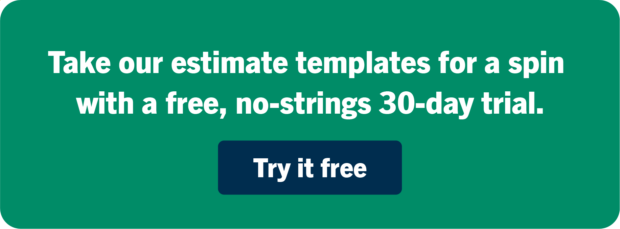
What does your electrical business need to bring in?
With no easy way to compare yourself to the competition, how do you calculate your electrician’s labour rate? Well, the best place to begin is with what actually works for you. How much do you need to earn as an electrician to make sure your bills get paid, there’s food on the table, clothes on the kids and dinner in the dog?
Break those basic costs down, come up with a ballpark figure per month, times it by 12 and you’ve got a minimum amount you need to keep you and your family ticking for the year. Let’s call this your essential costs. The stuff you really can’t do without.
But life’s not just about getting by. You don’t graft all day just to make the bare minimum. So let’s factor in some of the stuff that makes it all worthwhile – a holiday, a few days out, a few pints with your mates, a curry on a Friday night. Work out what you’d like to be able to do, and a total cost per year. We’ll call this your comfort costs. The things that get you through the week.
Finally, think about the costs of running an electrical business. What does it cost to run your van for a year? To insure it, tax it and fill it up with petrol? How about insurance, phone bills, accountants, advertising, tools and work gear? Add all of those up and you’ve got a yearly figure for keeping your electrician business going. We’ll call this your business costs.
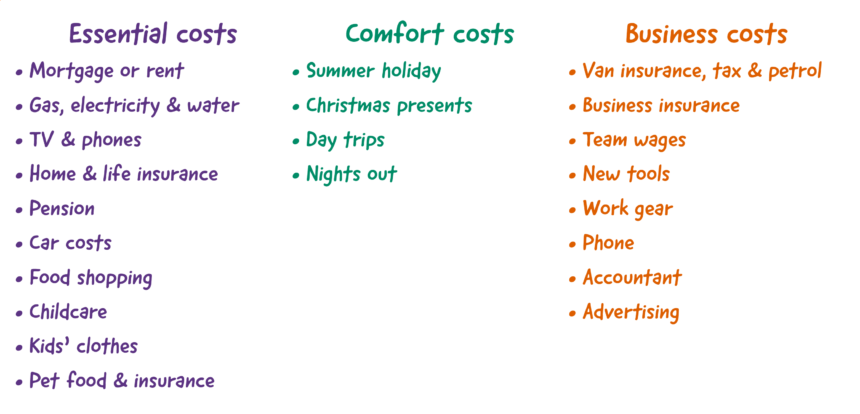

So, getting back to that annual salary, if you want to live comfortably (rather than on the edge of your seat), have the odd holiday and not be constantly worrying about making ends meet, you’re looking at: essential costs + comfort costs + business costs = minimum annual salary.
Of course, that’s just a baseline and you might well want to aim higher. Use your minimum annual salary as a starting point and set yourself a realistic target salary based on it.
Don’t forget, whatever salary you aim for, you’ll pay income tax out of it, which might affect your ability to meet those essential, comfort and business costs. To make sure you’re covered, check your tax rate and think about adding extra to your target figure to cover it.

Calculation 1:
essential costs + comfort costs + business costs = minimum annual salary.
Calculation 2:
minimum annual salary + ambition + tax
= target salary.
How to work out an electrician’s hourly rate
Once you’ve got your target salary, you can use it to calculate your electrician’s labour rate. Start by dividing your target salary by the number of days a year you want to work, minus holidays. According to Gov.uk, most employed people are entitled to 5.6 weeks’ holiday a year. As a self-employed person, you might want to match that, at least for starters.
On the other hand, you might want to go all-out for a couple of years and work even more – or take take things a little easier and work less. Decide what feels right for you – we’ll walk you through the maths so you can see if it’s workable, and you can play with the figures in our electrical rate calculator until you get the balance right.
So, target salary ÷ working days per year = your electrician daily rate. Divide that electrician daily rate by the number of hours you’d like to work per day and… Bingo! There’s your hourly rate too.
✏️ Pro tip:
Let YourTradebase do the maths. Scroll down to try our free electrician’s rate calculator.
Breaking it down: an example electrician’s salary
Here’s how that might work in practice. Say for instance you wanted to aim for a target salary of £33,000, take 6 weeks’ holiday a year and work 8 hours a day, 5 days a week.
Realistically, you won’t always be able to charge for every hour of your working day – you’ll be travelling, picking up materials, pricing up jobs, all sorts of stuff that takes you away from your hands-on, billable work. So, let’s allow for 6 of those hours a day being billable, absorbing the cost of those non-earning hours. Here comes the maths…
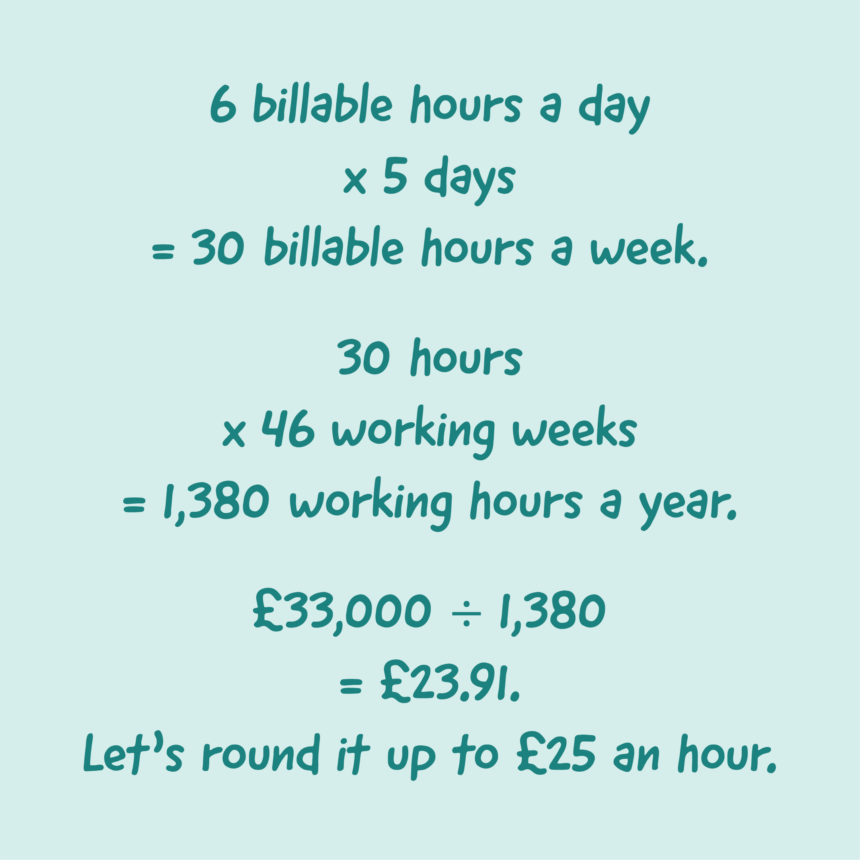
Of course you can (and probably should) charge more than that. It’ll give you more of a safety net, keep you comfortable if things go quiet, and possibly even help you look more of a pro. But if you don’t know the minimum amount you can charge, you don’t know where to start, right?
A quick way to calculate your electrician’s labour rate
If that feels like a lot of maths to get your head around, don’t worry, we’ve got you. Our quick electrician’s rate calculator does the tough stuff for you. Give it a go, play around with the numbers and get a clearer idea of what you can charge, how much you can work, and what you could be taking home at the end of the day.
Remember, the electrical rate calculator’s only going to do the maths based on what you tell it, so you still need to take a good look at the hourly rates it gives you to check whether they feel like reasonable, realistic figures you can quote to your customers.
Try our free electrician’s rate calculator
Remember, you’ll have to pay income tax out of this figure, but if you’re registered for VAT or sales tax, you’ll be able to charge that on top.
✏️ Pro tip:
Save your labour rates in YourTradebase and we’ll add your quotes up for you.
Write electrical quotes quickly and confidently
Once you’ve got a clear idea of what you need to charge to cover your costs and hit your earnings targets, it’s easier to stick to it every time you quote. You’ll have a ready-to-go hourly or daily figure that helps you feel more confident and justified in your pricing – which means you can crack on and quote electrical jobs faster.
In YourTradebase you can even set an emergency call-out rate for late-night, weekend or bank holiday jobs, so you’re getting a fair price for giving up your free time.
✏️ Pro tip:
Everyone deserves a pay rise every now and then, so review your rates once a year to check they’ve got you covered.
Boost your billable hours with YourTradebase
One sure-fire way to earn more as an electrician – without working longer – is to increase the ratio of billable hours to working hours. You might be working hard all day, but if you’re spending too much time on paperwork, you’re missing out on the chance to get hands-on and earn more.
YourTradebase saves tradespeople an average of a day a week on paperwork – a whole day you could be rolling up your sleeves and bringing in extra cash. It’s a made-for-trades toolkit full of quick, easy ways to blast through electrical estimates, quotes, invoices and more, sending out smarter stuff sooner, and winning more work, week in, week out.
How to price and estimate electrical jobs (to win!)
24 September 2020
Pricing electrical work when you’d rather be on the job (or the sofa) isn’t much fun. If you’re like most electricians we know, you probably hate being pulled away from hands-on work, or spending your evenings up to your eyes in quotes and estimates. And if all that paperwork doesn’t bring the work in, it’s easy to feel you’ve wasted your time. We get it. We’ve been there.
How to write electrical quotes, fast
The good news is, there are a few quick, easy ways to make your electrical quotes and estimates stand out – maximising your chances and making sure your time’s well spent. In today’s blog, we’re going to walk you through them step by step, looking at how to price and estimate electrical jobs faster, and better, so you can win more work. Ready?
First things first… why are quotes and estimates so important?
Pricing electrical work properly gives customers peace of mind and confidence about their project. Quotes are a really important way for them to compare tradespeople, see how you’ll handle the job and make a decision about who they’d like to use.
When customers ask for a quote or estimate, they’re not just trying to find the best price, they’re trying to make sure they find a knowledgeable, trustworthy electrician to work with. In fact, both Citizens Advice and The HomeOwners Alliance recommend customers get three written quotes before they give tradespeople the go-ahead.
Quotes and estimates also set expectations about the electrical work you’ll be doing, so everyone’s clear on what the job involves, and how you’re intending to approach it. As well as reassuring the customer, this can help to protect you if disagreements come up later.
What’s the difference between a quote and an estimate?
It’s really common for people to get quotes and estimates mixed up. Lots of customers – and even tradespeople – aren’t clear what the difference is. But there is one. And it’s a biggie. We’ve written loads about it in our quotes vs estimates blog, but here’s a quick recap:
- Estimates are a rough, informal idea of price, useful for giving your customer a ballpark figure before you’ve seen the job in person. They can change significantly once you’ve visited the site and got a concrete idea of what’s involved.
- Quotes are a formal agreement between you and your customer that you’ll do the electrical work described, for the price given – and they can be legally binding.
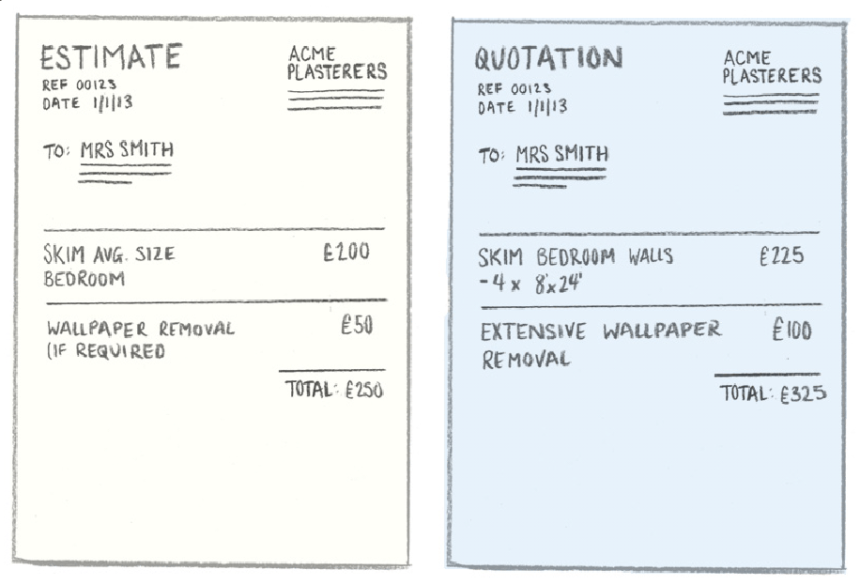
It’s really important your customer understands the difference between a quote and an estimate so aren’t upset if you need to increase your estimate once you’ve taken a closer look at the job.
💡 Tip: If you’re writing an estimate, give a few examples of things that could increase the cost if they crop up, like the customer’s current wiring failing an electrical safety test and needing fixing.
💡 Tip: Even though estimates are only a rough guide, they can still help you make a good first impression, so make them smart, clear and professional.
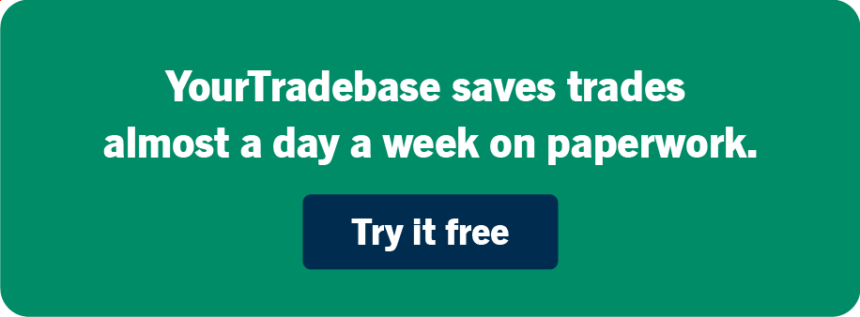
How soon should I send my estimate or quote?
The sooner the better! If you’re writing an estimate, try to send it out the same day. You’re only giving a ballpark figure, so if you’ve done a similar project before, get a head start by looking back at what you charged. Just be clear with them that the price could change when you see the job.
And if you’re writing a quote, try not to keep your customer waiting more than 48 hours. They want to make a decision and get on with the job, so make a good impression and help them out.
💡 Don’t let quotes and estimates build up. There are great tools out there – like YourTradebase – that can help you knock out great-looking paperwork in minutes. So take five in the van and get it all down while it’s fresh in your head. You can even send it there and then. You’ll be less likely to forget important details, your customer will appreciate the speedy response and you’ll have more time for your friends, family and sofa later!

What’s the best way to price up an electrical job?
If you’re wondering how to price and estimate electrical jobs better, there’s one box you’ve really got to tick. Whether you’re quoting or estimating, the figure you give needs to cover your labour costs + your materials. So how do you work them out?
- Labour costs: Make sure you’ve got an hourly rate for your labour, so you can use it whenever you’re pricing electrical work. It needs to cover your business overheads and add up to enough money each year to keep you and your family comfortable. There’s loads more on working this out in our blog, how to calculate an electrician’s labour rate.
- Materials costs: From cables to consumer units, sockets to switches, the price you give your customer needs to cover all the materials you’ll use on the job. As well as the actual cost of the materials, make sure you include a markup so you’re getting paid for the time it takes you to order, collect and bring those materials to site.
Get into the habit of learning from every job, by keeping track of your quotes and whether each job was actually profitable in the end. That way you’ll be able to use your prices again as a starting point for similar jobs, without losing out or starting from scratch.
💡 Tip: YourTradebase automatically saves your tasks and prices in your personal price list, so you can pick and choose whenever you quote – saving a truckload of time.
Build a personal price list & quote faster with YourTradebase.
How should I write my estimate or quote?
There are lots of tools out there for writing up your prices, from a biro and a bit of paper to specially designed, time-saving apps. So what are the pros and cons?
Writing by hand
Pros:
- Doesn’t take any training
- No need for the internet… or electricity
- Er… we’re struggling for positives with this one!
Cons:
- You only get one copy
- It might not be easy to read
- It doesn’t look professional or reassuring
Word or Excel
Pros:
- Looks more professional
- No problem understanding handwriting
- You can save, print and email copies
Cons:
- Can be slow and tricky to set up
- Hard to make it look really good
- You end up with loads of files to keep organised
Installed software
Pros:
- Looks professional
- Easier to make multiple copies
- Easier to save and re-use quotes (sometimes)
Cons:
- Can be really expensive
- You’re chained to your home / office computer
- Takes time to install, maintain and update
- Can take time to get to grips with
Quoting apps
Pros:
- Looks professional
- Easy to save and re-use your prices
- No need to download anything
- Easy to quote on the go
Cons:
- Usually a cost of some kind
- Can be a learning curve

What should I include in my electrical estimate or quote?
For starters, think about what your customer might expect to see, what’s going to help them… and what’s going to knock their socks off. If you can cover all of those bases, you’ll have a really stand-out quote with a great chance of winning the job. Let’s take a closer look…
What do customers expect to see on an electrician’s estimate or quote?
- Their name and address. Make sure everything’s spelled right!
- A breakdown of the work involved. Be clear and detailed – it’ll make you look professional and help to avoid any confusion or argument later on. It’ll also give your customer peace of mind about what they’re getting – and for how much.
- The total price. Make sure it’s clear whether this includes any VAT or taxes.
What is it helpful to include on electrical estimates or quotes?
- How long the estimate or quote is valid for. This can protect you from having to stick to your prices if the customer takes a long time to go ahead with the work – or materials costs go up. It also adds some gentle urgency, helping to put a time limit on the customer’s decision making.
- Whether your customer needs to pay a deposit, and by when. If you’re pricing a large electrical job, or buying expensive materials, you might prefer to be paid some of the cost up front. If so, be clear about your payment schedule and what you need to get started.
- A reference number. This is just as helpful for you as for your customer, making it easier to find quotes quickly if anyone has any queries. It’s also a really simple way to look more organised.
- Terms and conditions. You can include these with your quote or estimate, or just add a link to your website where they can find them in full. Either way, you’ll be helping to protect both of you by making everything super clear, up front. Again, it’ll also make you look like a professional they can trust with their electrical project.
- Your VAT number, if you’re VAT registered. Again, this gives people the peace of mind that your business has been properly registered and is paying tax.
What’s going to make my quote or estimate really stand out?
- Smart presentation, including a clear (not fuzzy!) logo.
- Your full contact details. Showing you can be easily reached is reassuring for the customer and comes in pretty handy when they want to give you the go ahead.
- Logos of any trade associations you’re a member of, or any accreditations you’ve earned. They’ll help you look knowledgeable, accountable and trustworthy. And to save you hours of searching, uploading and wrestling with dodgy resolution logos, we’ve saved a whole bank of them in YourTradebase, including NICEIC, ECA, Napit and Elecsa.
- A friendly, reassuring introduction. Add this at the top of your quote (or estimate), in your covering email, or better still, in both. If you’re struggling for what to say, YourTradebase has a whole bank of ready-written messages you can use to make a great first impression.
- A clear idea of what happens if they want to go ahead. You’ve spent valuable time getting your quote or estimate ready, so don’t leave the customer wondering what’s next. Invite them to give you a ring or drop you an email if they’d like to go ahead, or to pay the deposit if you need one.
💡 Tip: It’s always good to show you’re approachable, so invite customers to ask questions if they want to. In YourTradebase they can ask questions online and even accept quotes instantly, just by clicking on your quote, on any device.
How much detail does an electrical quote need?
It’s a balance. Give your customer enough detail that they feel clear and confident about what they’re getting… but not overwhelmed. They don’t need to know the price of every cable clip.
Giving more detail than the competition can help you win a potential customer’s trust, pave the way for a smooth-running job and protect you from any disagreements later. But think about the way you describe the work you’ll be doing, and focus on what the customer will get rather than the technical things you’ll have to do to achieve it.
Marketing expert Samuel Hulick explains it pretty neatly, with a little help from Mario:
“People don’t buy products; they buy better versions of themselves. When you’re trying to win customers, are you listing the attributes of the flower or describing how awesome it is to throw fireballs?”
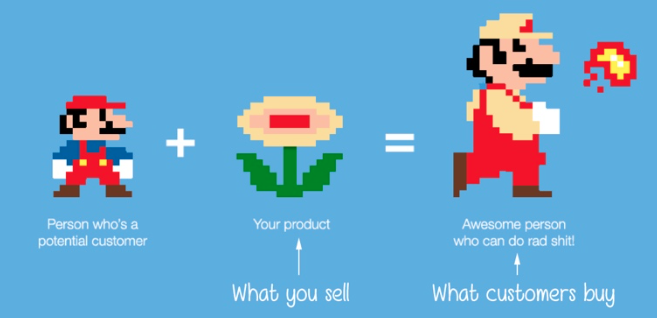
When it comes down to it, the customer’s buying the end product, and the benefits it brings, so for example, instead of saying: “External installation of LAP AR0506 LED PIR bulkhead black 670LM 8W”, which is pretty baffling to the customer, you could say: “Fitting an LED security light with sensor to garage wall, automatically lighting up the driveway.”
💡 Tip: In YourTradebase it’s easy to choose the level of detail you want to show, whether that’s a full breakdown of material costs and quantities or just the total price with everything included.
How can I make quoting for electrical jobs even easier?
Whether you’re writing a quote or an estimate, the biggest thing you can do is stop starting from scratch every time. Use tools that create shortcuts, help you price consistently and speed up the whole process. For example:
- Create a quote or estimate template. That way your logo, contact details, trade accreditations, VAT number etc can be already laid out, looking good and ready for you to drop in the job specifics each time. It’s easy to do in YourTradebase – just start with one of our templates, save your details and boom, you’ve got your own branded template ready to use anytime.
- Have a templated cover email ready to go. Write a message you’re happy to send out with every quote or estimate, then save it and just drop in each customer’s name and job details before you fire over their price. Or make it even easier and pick from a whole bank of friendly messages we’ve already saved in YourTradebase.
- Keep track of your prices. Make sure you know where to find prices you’ve quoted in the past, and whether those jobs were profitable in the end. That way, when a similar job comes up again, you’ll have a starting point to work from. In YourTradebase, we automatically save your tasks and prices in your personal price list so it’s really easy to look back, pick and choose.
- Have a quick, easy way to check materials costs. Lots of the big suppliers have apps you can search quickly even if you’re on site, giving you an up-to-date picture of costs and availability. There’s more on this on our blog on apps for electricians.
- Quote sooner. Less head scratching and memory jogging means quicker, more accurate quotes. And sending them out sooner helps give you the edge on the competition.
Five sure-fire rules for writing better electrical quotes
- Price up quickly
- Say whether it’s a quote or estimate
- Give a clear price breakdown
- Look smart & professional
- Add a friendly note about what’s next
What does a great quote look like in YourTradebase?
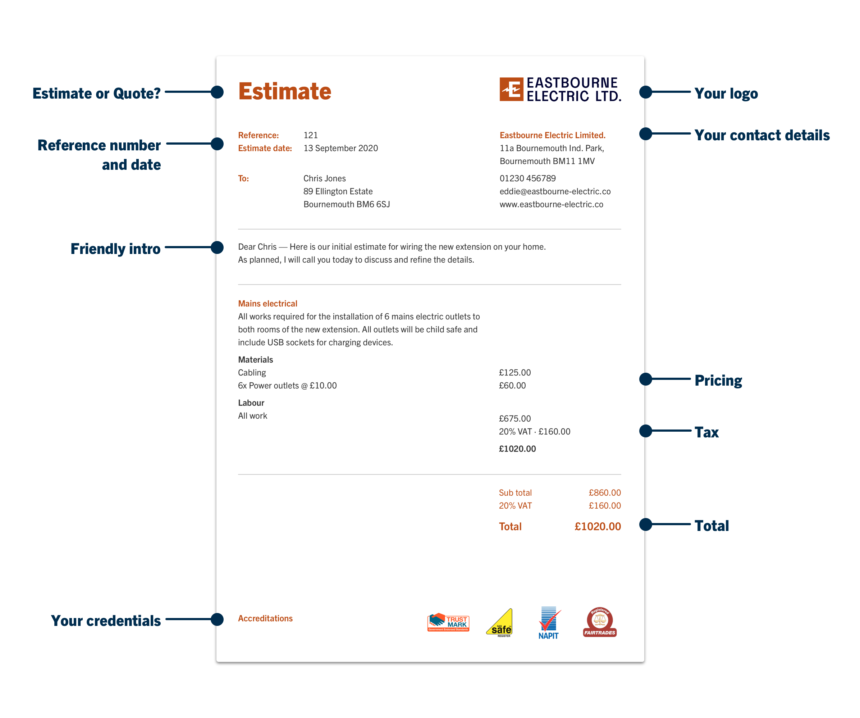
YourTradebase is the quick, easy quoting and estimating app, made for trades. It’s packed full of features that take the headache out of pricing electrical work – and help you win more jobs.
Estimating electrical work: the best software out there
22 September 2020
However hard you work, there are never enough hours in the day. And the last thing you want to fill them with is paperwork. Writing quotes and estimates takes you away from the hands-on graft that pays the bills – but what if you could crack through it faster with a few nifty apps?
There’s a whole load of powerful electrical estimate software out there, designed to help you write electrical estimates faster – and better. Which means you can save time, hassle and hard-earned cash, straight from your phone. With hundreds of electricians’ apps on the market, we’ve picked the hardest-working, easiest-to-use options – tried, tested and loved by sparkies.
Check out our favourite apps for easier electrical estimating…
Let’s face it. There’s a lot to think about when you’re pricing up a job: time, materials, travel, overheads, budgets, competition… Get it right and you won’t just win the work, you’ll go home well paid and happy. Get it wrong and you might just get stuck with an unprofitable job – while someone else scoops up the great work you can’t get to.
Luckily, there’s a truckload of helpful software for estimating electrical work out there, making it easier to price up quickly and accurately, protecting those profit margins. We know you’re too busy to sift through every electricians’ app going, so we’ve tried a bunch for you, and asked the sparkies we know.
The result? A handy guide to the best electrical estimate software you can fit in your pocket – from cable calculators that help you get a handle on the job, to mileage counters that track those travel costs. Let’s take a look.
One quick way to earn more? Get fast at paperwork. You’ll grab more grafting time, get more done and bill more, every week. Click To TweetMeasuring and calculating apps for electricians
Electrical measuring and calculating tools can really help you get your head around a job and what it’ll take to get it done. The more complex the job, the more useful they are, helping you map out what’s needed and design a safe, effective solution. And with all that at your fingertips, it’s easier to write an electrical estimate that really covers your bases…
Megger Cable Calc+
A free app from electrical heavyweights Megger, this cable calculator is a go-to tool for loads of electricians. It’s stuffed with cable options and volt drop calculations, and it’ll help you get to grips with a range of electrical testing instruments too. The best bit (apart from it being free), is that you don’t need an internet connection, so you can get instant results, whatever state your site’s in.
Electrical Tools and Reference
Electrical Tools and Reference – or The Electricians App – is a really handy chunk of software for electricians that gives you quick, easy access to a whole range of guides, tables and calculators. Print off charts, look up cable ratings, get a Zs value or do volt drop calculations. And while you’re at it, work out kVa, fault currents, ring circuits and a shed load more. Handy.
Cable Sizer
This popular app’s designed to help you make accurate cable size calculations super fast. Fill in your circuit parameters and it’ll tell you which cable to use, taking into account current carrying capacity, earth loop impedance and voltage drop – or set your own cable size and use it to check you’re good to go. Again, no internet needed, so it’s great out on site.
💡 The right tools help you get to grips with what’s needed, for electrical estimates that protect your profits.
Merchants’ pricing and sourcing apps
Some of the biggest electrical and trade suppliers now have their own apps, making it quick and easy to check costs, assess availability and order materials on the go. Less guesswork, fewer trips to the merchants and more precise electrical estimates.
As well as giving you accurate prices in seconds, some of these apps let you scan bar codes to find products faster, and most show you what’s in stock locally – potentially making a big difference to the materials you choose, as well as your travel costs and project schedule.
Every sparky’s got their favourite suppliers – whether they’re cheaper than the rest or just easier to get to – so look up your go-to merchant and see what they’ve got app-wise. You might be surprised how much easier it makes things. We like the features (and the reviews) on CEF’s app, and it’s worth taking a look at Screwfix, B&Q and Wickes too.
💡 Price up materials like a pro and make a healthy margin, every time.

Travel and mileage apps for small businesses
Getting to sites fast and keeping tabs on your travel costs can make a big difference to the accuracy of your electrical estimates and quotes – and your ability to make a profit. Which is why a couple of nippy travel apps can make all the difference…
Google Maps
These days, using Google Maps is a bit of a no-brainer. It’ll help you find the fastest route from A to B, check how many miles to factor into estimates, keep a real-time eye on traffic jams and make sure those further-away jobs don’t leave you out of pocket. But there are also some great apps out there to help you keep tabs on your mileage, without a big pile of Post-Its…
MileIQ
This handy app helps you work out your mileage expenses and it’s free for the first 40 trips you make each month. Just leave it on and it’ll automatically track how far you’ve travelled so you don’t have to remember. It sorts out your personal trips from your business ones, helping you save time – and money – every time you take the van out.
Mileage Tracker
Along the same lines as MileIQ, this app’s designed to help you track your trips and pull together all your mileage details so they’re ready to use in your tax return. As well as helping you get your annual paperwork in order, it’s a great way to get clearer on the miles you’re clocking up, so you can start factoring them in whenever you write an electrical quote or estimate.
💡 Travel isn’t free. Don’t forget to allow for your time, fuel and overheads whenever you write a quote.
Electrical estimating software for trades
We’ve looked at apps that help you scope out your jobs, price up your materials and make enough on your mileage, but once you’ve got all that figured out, what can you use to knock out great electrical estimates and quotes, in no time?
YourTradebase
Made just for trades, YourTradebase turns quoting into a quick, easy job you can fit in anytime – on the go, on site, or even on the sofa. It cuts out repetitive tasks, saves important stuff and helps you write electrical estimates faster, the more you do it.
First, the app automatically saves contact details for you and your customers, so you don’t have to add them every time. Next, it stores every task, material and project you price up, building a personal price list you can draw from whenever you quote. Once that’s done, it adds the right taxes, gives everything a reference number and tots the whole thing up for you. Boom.
You can save your branding so it drops in automatically, and even pick from a ready-to-roll library of trade accreditation and association logos (including NICEIC, ECA, Napit and Elecsa) that give your quotes and estimates extra clout. And if you’re ever lost for words, just choose from a bank of friendly quote intros and ready-written emails that’ll knock your customers’ socks off.
Finally, YourTradebase lets you fire off your estimates, quotes and invoices there and then, straight from the app. You can see when they’re opened, answer customer questions and even get instant approvals (with a signature!) right on your phone.
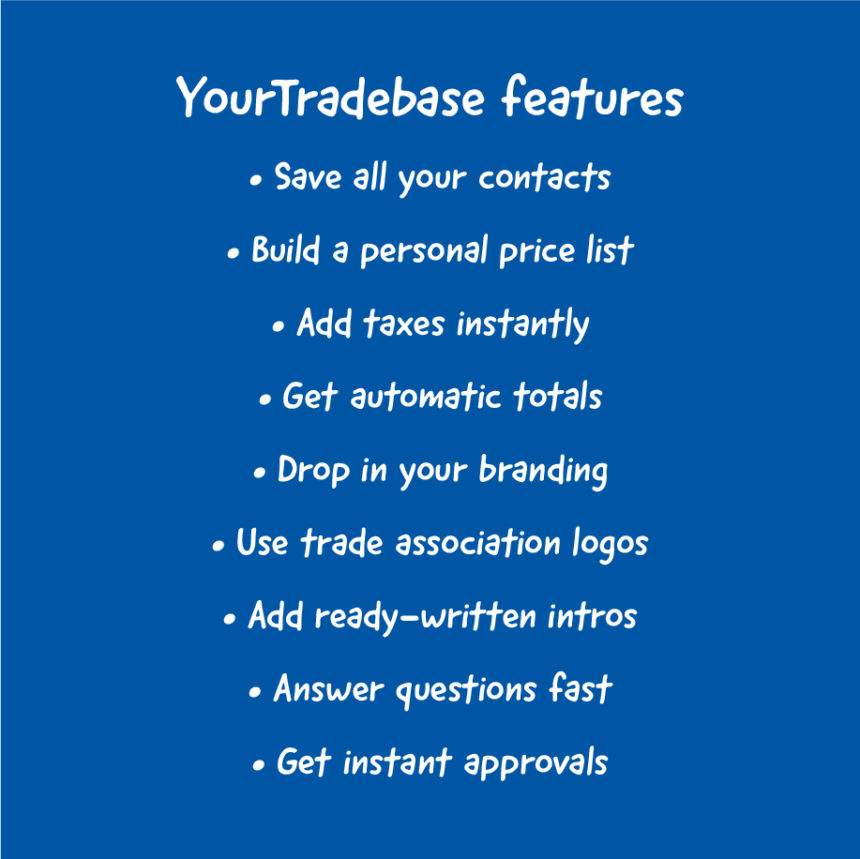
💡 YourTradebase is packed with trades-only tools that make estimating easier.
Powerful tools you can try in minutes
The right tools make all the difference. So save yourself time, protect your profits and make a great impression with electricians’ apps that really help you get to grips with pricing – from planning your project to sourcing the best products and sending a totally knockout quote.
We’ve looked at lots of helpful software for estimating electrical work, and it’s all available from the App Store, or whenever you usually get your apps. You can download any of the apps in minutes and use them today – we’ve got our fingers crossed they’ll be game changers for you.
And if you fancy trying YourTradebase, grab a free, no-strings trial today. With a truckload of quick, easy, paperwork-busting tools, it saves tradespeople almost a day a week on admin. Take it for a spin and see how much time it could save you.

The 5 most-used electrical estimating methods
21 September 2020
Ask any electrician what they love about their job, and chances are it won’t be estimating. When you’re just starting out, it’s pretty daunting – how do electricians price up work, charge for their time and estimate enough… but not too much? And even if you’re a seasoned pro, how do you know you’ve found the quickest, easiest way to estimate – or the way most likely to win work?
Worry not, we’ve got you. In today’s blog we’re looking at the five most common electrical estimating methods, and weighing up their pros and cons. We’ll break them down, look at how electricians price up jobs in different ways, and help you hit on the one that works for you – so you can price up faster, better and with a lot less stress.
The right electrical estimating methods can make all the difference
Estimates bring in work. They’re a massively important part of any electrician’s business, but we’re all guilty of putting them off, pushing them back and finding other jobs to do.
It’s easy to see why. When we don’t know what a customer’s expecting, what the competition’s quoting, or whether we’re working it out right, we’re not exactly filled with confidence… so we drag our dreaded paperwork out. Even worse, when we get estimates done and the customer goes elsewhere, it’s easy to feel like we’ve wasted our time.
So let’s fix this. Let’s pin down the best electrical estimating methods and give you an easy, effective formula that gets estimates out fast – and wins work – time and time again.
Show paperwork who’s boss and finish on time for once. Click To TweetLet’s break down the big electrical estimating methods and find the right one for you…
Ok. Everyone’s different, and what feels like common sense to one electrician might not to the next. That’s why we’re going to look at the pros and cons of five electrical estimating methods. We’ll break them down – you take your pick.
1. Time + materials
Let’s kick things off with the time + materials approach. It’s a practical, reliable electrical estimating method based on how long a job’s going to take, plus the cost of materials. As well as helping you work out ballpark estimates, it gives you enough detail for full electrician’s quotes too (not 100% clear on the difference? Check out our Quotes vs Estimates blog).
You’ll need a couple of things to get started with the time + materials approach. First, a clear idea of what your hourly rates are. Working out a realistic rate that covers your living and business costs gives you a solid starting point for more confident, consistent estimates and quotes. If you need a hand, read our blog on how to calculate your electrician’s labour rate.
Second, you’ll need a quick way of costing up electrical materials. These days most suppliers have websites and some even have apps that speed the process up (check out our quick guide to great apps for electricians for some tips). Don’t forget to mark up your materials to cover your time sourcing them and getting them to site.
The pros
This formula-based framework makes sure you cover your costs, get paid at a decent rate, charge the right amount for materials and don’t lose out. It’ll give you the confidence that there’s strong reasoning behind your prices, which you can break down in detail if need be, showing how honest, methodical and professional you are.
The cons
It can be nerve-racking to work out a labour rate, (although this blog will help) and even if you work out how many hours the job needs, there’s a chance it’ll run over. That’s a risk, whatever electrical estimating method you use, but at least if you’ve listed your expected hours, you stand a chance of convincing the customer the job was more complicated, and negotiating a little extra.
Go with it if…
You like the idea of a strong formula that covers your costs.
Avoid it if…
You’re uncomfortable setting an hourly rate (you shouldn’t be!).
✏️ Pro tip:
Save regular materials prices in YourTradebase for faster estimates, every time.
2. The guesstimate
Next in our run-through of electrical estimating methods… the guesstimate. Otherwise known as pulling a figure out of the air based on your experience and assumptions. Yes, it’s about as precise as it sounds, but remember an estimate’s a ballpark figure rather than a price you can be held to. When it comes to full-on quoting, it’s risky, so tread carefully.
The pros
It’s certainly quick… with a whole lot less working out. And if you’re very experienced, it might just be reasonably accurate (fingers crossed). We’re struggling for more plus points though.
The cons
Without a real basis for your figures, you’re more likely to undercharge or overcharge, which could leave you out of pocket, put potential customers off or even lead to disputes later on. And if your customer feels you’re guessing, it won’t make you look very professional, or generate much faith.
Go with it if…
You’ve got tonnes of experience and you’re super clear it’s a ballpark figure.
Avoid it if…
You’re new to the game or your customer wants a definitive price that won’t change.

3. Working to a budget
Onto our next electrical estimating method – and this one’s a little different. The working to a budget approach puts your customer in control. Just ask them what their budget is for the electrical work, then tell them what you can do for that price. It’s more suited to projects than quick hour-or-so jobs, but it’s worth thinking over.
The pros
When it goes well, this electrical estimating method can be a real people pleaser. Your customer feels they’re in the driving seat, being listened to and accommodated – and they’re comfortable with what they’re spending.
From your point of view, as long as the budget they give you is realistic, you’ll know the price you’ve got to hit to get your estimate accepted. Less guesswork for you (but more for them).
Finally, there’s always the chance your customer totally overestimates and gives you a nice big budget, so you you can put in a comfortable estimate with a guaranteed profit, and still make them happy by coming in for less. If there’s still a lot of budget left when you’re finished, you could even bring the final price down – a powerful way to win trust and loyalty.
The cons
Most customers have no idea how long electrical jobs take, or what expertise and materials they involve. You’re the expert, so it’s a risky move to put the pricing in their hands.
If you know they’re taking the same approach with competitors, it puts a lot of pressure on you to come in below what might already be a pretty low budget. And if you can’t possibly do the work for their budget, you’ll be on the back foot before you’ve even put in your price – not a great start.
Go with it if…
You’re confident they’ve got a decent budget or happy to tell them if they’re way off.
Avoid it if…
You feel you might be squeezed on price or they seem like a tricky customer.

4. Picking from a price list
The price list approach (also called a schedule of rates) is used by thousands of sparkies as a really useful way to write estimates or quotes quickly. It involves using your experience, along with a good understanding of your hourly rate and materials costs, to build a ready-to-go list of prices for regular jobs like installing new power points, changing LEDs or putting up lights.
The pros
This electrical estimating method is super useful for jobs you do week in, week out. You know what they involve because they’re your bread and butter. In fact, you could practically do them in your sleep, so there’s no need to price from scratch every time. Whether they’re small jobs or bigger projects, if you know you can deliver for a certain amount, it’s a great short cut.
As well as speeding up your estimating and quoting, the price list approach encourages you to learn from experience and keep track of your prices, so you can get faster and more accurate at pricing up the more you do it. Plus, if you want to find out what the competition’s charging, it’s easier to ask someone what they paid for a specific task and benchmark yourself against it.
In YourTradebase, we actually help you build your price list with every estimate or quote you write. Our app saves your prices automatically, so you can pick and choose from them next time.
The cons
A job that might initially seem the same as a previous one could prove more complicated, so only use your price list when you’re confident you know the score. For extra protection, include plenty of detail in your estimate or quote, so if the actual job demands something different, you’ll at least have a basis for negotiating more money.
Go with it if…
You do the same tasks regularly and want to get faster at pricing up, every time.
Avoid it if…
You rarely do the same job twice.

5. It takes as long as it takes
This one isn’t so much an electrical estimating method as a state of mind. The it takes as long as it takes approach is a way of working with long-term customers that depends on (and fosters) trust and loyalty. Do what’s needed, keep tabs on your costs and tell them the price at the end.
The pros
If you’ve got a strong, established relationship with a customer and they’re happy to work this way, great. It means if you’re honest with them and get the job done in a reasonable time, you’ll never be out of pocket for the work you’ve done – every hour gets paid for. You’re building a partnership based on trust, mutual respect and clear communication.
The cons
Fallouts happen, and this approach does leave you open to disagreements over price, which could leave you with less money than you deserve – and little legal backup. Don’t rush into this kind of agreement until you’ve done a handful of properly estimated jobs for the customer.
Go with it if…
You’ve been working together for years, you trust each other and you talk regularly.
Avoid it if…
You don’t know the customer well or you have any doubts at all – trust your gut.
✏️ Pro tip:
Track all your customer messages automatically in YourTradebase.
Which electrical estimating method is right for you?
There are pros and cons to every electrical estimating method, so it all comes down to the kind of jobs you do, the kind of customers you’ve got and what you feel most comfortable with.
While the working to a budget approach creates certainty for the customer and the takes as long as it takes route can help to cover every hour you work, the time + materials and price list based approaches are the safest, most professional options in our experience.
They give you a great formula for speeding up the quoting and estimating process, building your confidence and creating shortcuts you can use again and again.
They also interlink – the price list approach has its roots in a great understanding of time + materials. So once you’ve worked out how much time and materials you need for a regular task, it can become an item on your price list, without you having to do those calculations every time.
A faster way to work out your prices
Building a price list in YourTradebase is really, really easy. In fact, we do it automatically. Every time you write a quote or estimate, we save each task to your price list so you can pick and choose from it the next time, and the next. So without any extra work, you get a super useful shortcut that speeds up the whole process, based on the prices you personally want to charge.
With quick estimate templates, a library of trade logos, easy ways to save your details and ready-written customer messages, YourTradebase also makes writing up and sending your prices really fast and polished too. You can even answer customer questions and get instant approval online – going from first enquiry to shiny green light faster (and more painlessly) than ever.
Cold weather tips for builders…
4 February 2020
Grafting on site in the depths of winter is pretty grim, so what’s the best way to stay warm and working, however baltic it gets?
There’s a January and February (and March) in every year, but somehow the really cold weather always seems to come as a surprise. It feels like those heavy frosts, below-freezing temperatures, snowy mornings and dark days are out to get you – stopping you getting stuff done, stalling your schedule and making your building site a pretty miserable place to be.
So what’s the secret to getting through winter on site? To pushing on through and keeping your business strong? It’s all about thinking ahead and being clever with your days. Get it right and you’ll have less downtime, happier customers and a better start to your year. Here’s how…
Weather-proof your workload
Ok, so those big freezes and snowfalls tend to come without much warning, but you know it’s winter, right? Things always take longer when the conditions are bad, and there’s bound to be the odd day that’s a bit of a write-off.
So, when you’re planning winter building jobs, try to allow for that. Plan in extra time from the start and give yourself enough breathing space to work safely, squeeze in the odd emergency job (there’s always something) and still meet those (more realistic) deadlines. You’ll be glad you did.
Plan your winter workday
On short winter days, plan indoor tasks for those first and last few hours, and snatch the middle of the day for outdoor work. It’ll help you be more productive, get better results, avoid re-dos and keep your team happier too.
Some jobs, like wet trades, just can’t be done when the temperatures get too low. Mortar won’t mix, bricks might need to be re-laid, and concrete and render can crack – or take forever to get strong. You can’t change any of that. So try to plan this work for warmer months, or crank up some workspace heaters and tackle the problem head on.
Whether you buy your own heaters or hire them for the job, they’ll help materials and equipment work properly despite the weather, making them a pretty sound investment. The same goes for extra lighting, which can help you pack more hours into your day – and stay safe and well.
We’ve built a pretty nifty schedule tool in YourTradebase to help you plan jobs better. Take a quick look or hop on a free trial.
Stay warm on site
Cold, dark days bring all sorts of risks on building sites and as trades, we literally can’t afford to take them. Making yourself ill or having an accident can wipe days or weeks out – and that means you won’t get paid, you’ll miss out on work and you’ll struggle to catch up.
So stay warm. Whether you’re working outside or on an unheated site, layer up with this lot…






Remember, those extra layers might make moving around and operating equipment feel different or difficult, so take extra care, go slower if you need to, and stay safe. Some machinery doesn’t like the cold either, so go steady. It’s understandable that you want to crack on and get finished, but be realistic about what you can do and take extra care.
Keep eating and drinking
Ok, we know that’s tough. But keep the tea flowing, eat warm food if you can, and step inside often to eat or drink it. It’s really important to warm up regularly – even if that just means five minutes in the van to remember what your fingers and toes feel like.

While you’re warming up, you can always grab some van time and blast through a few quotes, send out some invoices or get back to a few customers – it’s all about using the time well to save yourself stress and hassle later. And it’s surprising how much admin you can do in ten minutes.
Get your work van winter ready
While we’re on the subject, make sure you kit out your van for cold days too. Breakdowns are much more likely when the temperature drops and if you can’t get to site, you can’t work, earn or keep your customers happy.


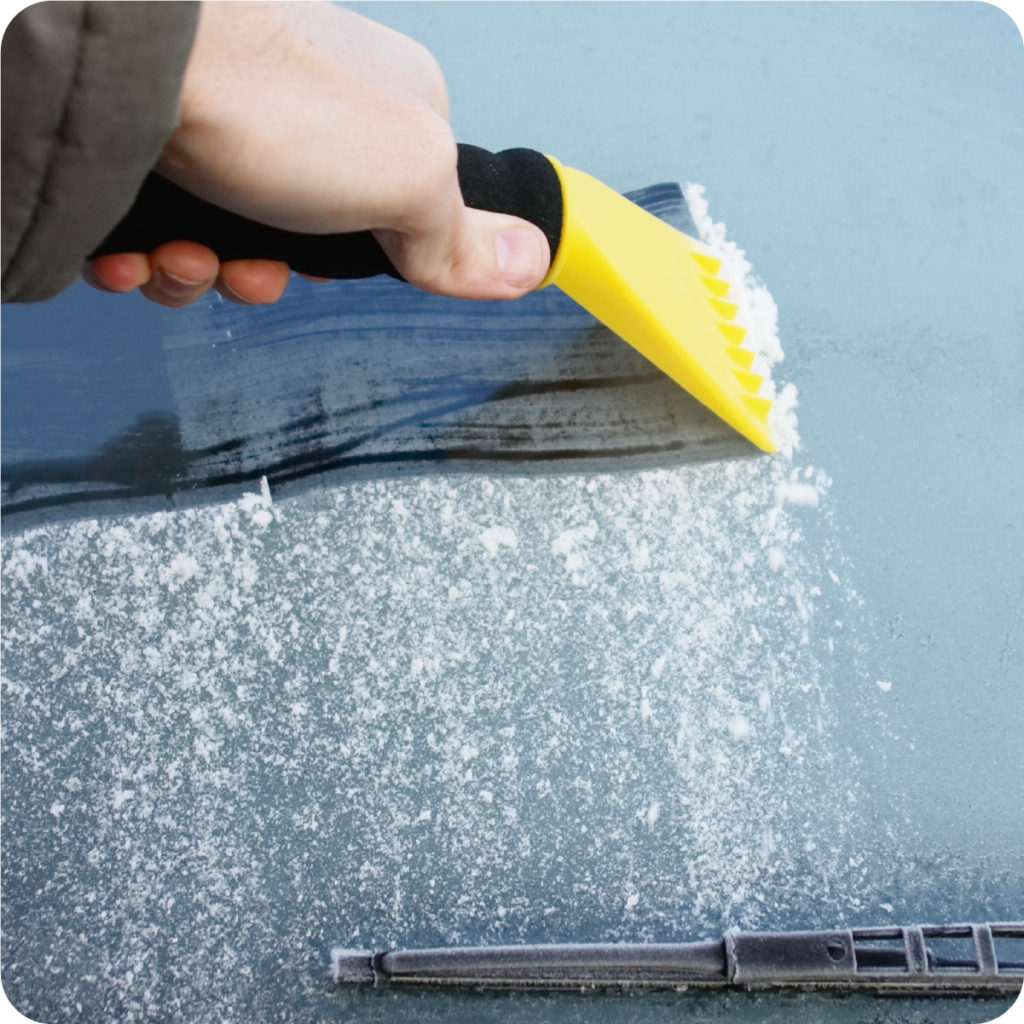



Sort out your trade insurance
If an accident’s going to happen, it’s going to happen in poor light and icy conditions, so make sure you’ve got good cover – for you, your team, your kit, your customers and their property. Give site security some thought too – darker days mean more risk of theft, so you might want to rig up some CCTV, lock up your site or take your tools home.
Know when to shut down the site
Some days, the weather’s just going to win, and getting the things you planned to do done… well, it’s just not going to happen. But that doesn’t mean your day needs to be wasted. It might be the perfect time to squeeze in a quick job for another customer – one of those urgent winter repair jobs or something else that’s 100% indoors.
On the other hand, it’s also a great time to get your admin in order – freeing up your evenings and weekends for all those things you’d much rather be doing. Catch up on quotes, invoices and callbacks from home – with all the no-nonsense tools and templates in YourTradebase it’s quick, easy and doable from the kitchen table, or even the sofa.
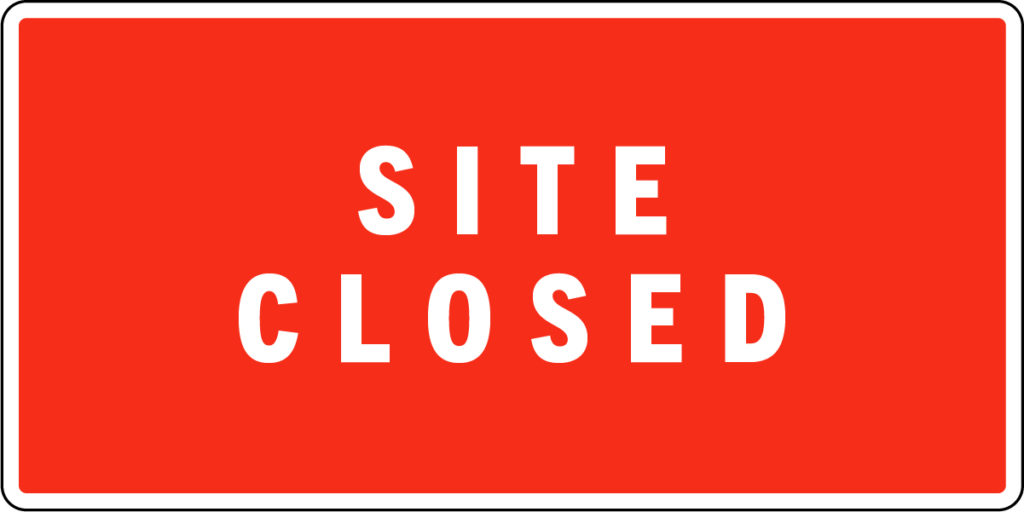
If you’ve got a bit more time, how about asking some of your favourite customers for testimonials or using our new ‘Extra customer info’ forms to give your customer records a bit of a boost? Right now you might be able to remember that Mrs Smith had a Baxi boiler and it needs servicing in September, but by the time September rolls around… well, you probably won’t.
Get all that info down – along with anything else that might be helpful, like how customers heard about you. It’ll show you what you’re doing right and wrong when it comes to spreading the word. By the end of the day, you might just have fuller records that help you promote your business, look after your customers better and feel super organised when the snow starts to melt.
Let’s do this
So, don’t wait for that freezing cold morning when the van’s a foot deep in snow. Get prepped now, have a plan for the worst of the weather and use your time to get a load more stuff done.
Keep warm out there!
Hello 2020… goodbye Word & Excel
15 January 2020
People, it’s time. Stop struggling with Word and Excel and grab a better power tool for your paperwork…
This new year, make smashing through your admin as easy as it should be.
The right tools make a massive difference. We’ve all been there, out on site, battling away with a saw that’s not sharp enough, a drill that’s not powerful enough or a ladder that’s not long enough. It’s not fun. It makes a quick job a slow one, and a great finish hard to achieve.
It’s just the same with paperwork. Struggling with tools that aren’t quite right for the job – or up to the job – makes knocking out a quick quote so much harder than it should be. Which means it takes longer to do, gets put off day after day, and doesn’t look great even when it’s done.
You wouldn’t put up with it on site, so why put up with it for your paperwork? All you’re doing is adding to your stress levels, eating up more of your evenings, and churning out admin that doesn’t do you justice. Better is out there.
Secretary or sparkie?
There’s no getting away from it – Word and Excel are powerful tools. They wouldn’t be used by millions of people if they weren’t. But one size just doesn’t fit all. And really, why should something that works for an accountant, a secretary or an HR manager be right for the best builder in Bromley, or the fastest sparky in Southend?
It just doesn’t make sense. Every other tool you use is designed for jobs like yours – so why should it be different when it comes to your admin? There are tools out there made for trades – made to suit the kind of work you do, and the kind of days you have. And those tools are a solid investment. Time is money, and they’ll help you spend more of it earning, not doing admin.
Fancy making 2020 the year you stop struggling and start using a paperwork power tool that’s right for you? Let’s take a look…
Time-saving templates
Ok, so there are templates in Word, but they’re not exactly geared to getting you paid. They might help you knock up a nice CV or report, but that’s not really what you’re after, right?
So, look for an app, or piece of software, that gives you templates you actually need – shortcuts that help you blast through paperwork faster and save a tonne of time. At YourTradebase, our reusable templates cover everything from estimates, quotes and invoices to a whole bunch of emails you might want to send.
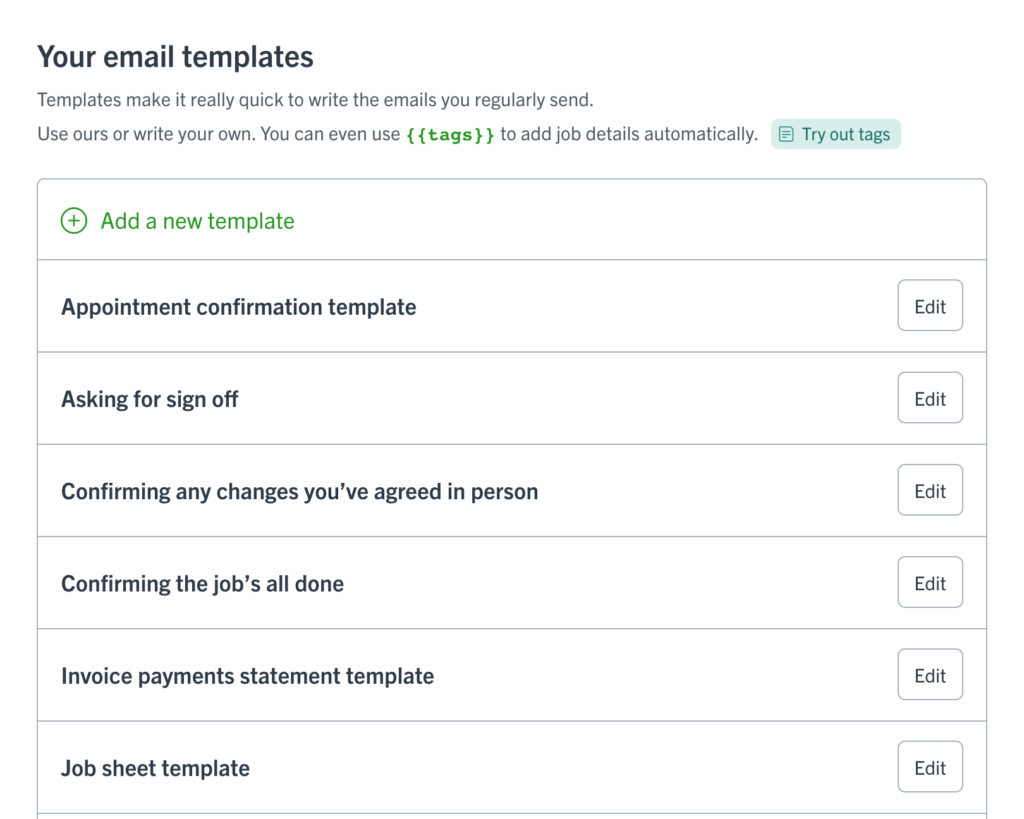
Want to chase up a quote? We’ve got a template for that. Want to agree a start date? We’ve got a template for that. Want to confirm a few changes? Yep, you guessed it. The whole point is to help you get your admin jobs done well, in a fraction of the time.
Price lists you can personalise
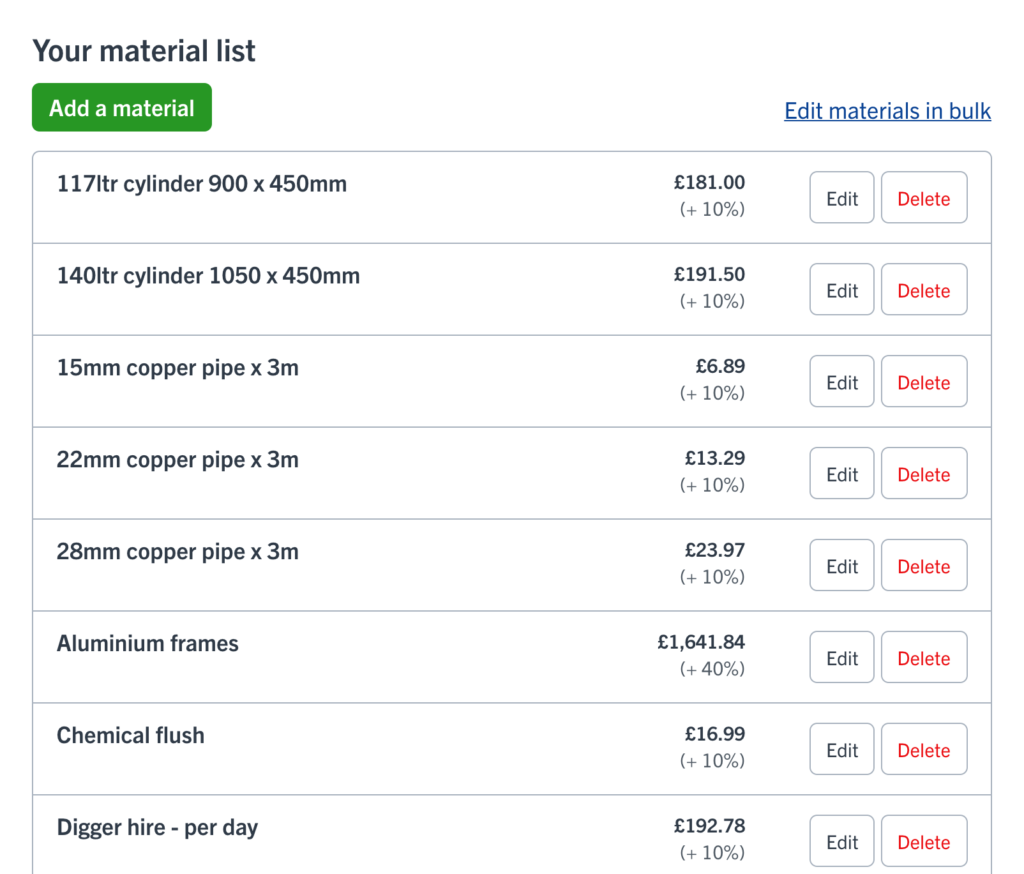
Another handy thing to look out for are price lists you can build and save, so you can pick and choose tasks, labour costs and materials you use regularly. In YourTradebase you can completely personalise them based on what you usually charge, saving you a tonne of maths time and letting you get those quotes together faster.
Paperwork you’re proud of
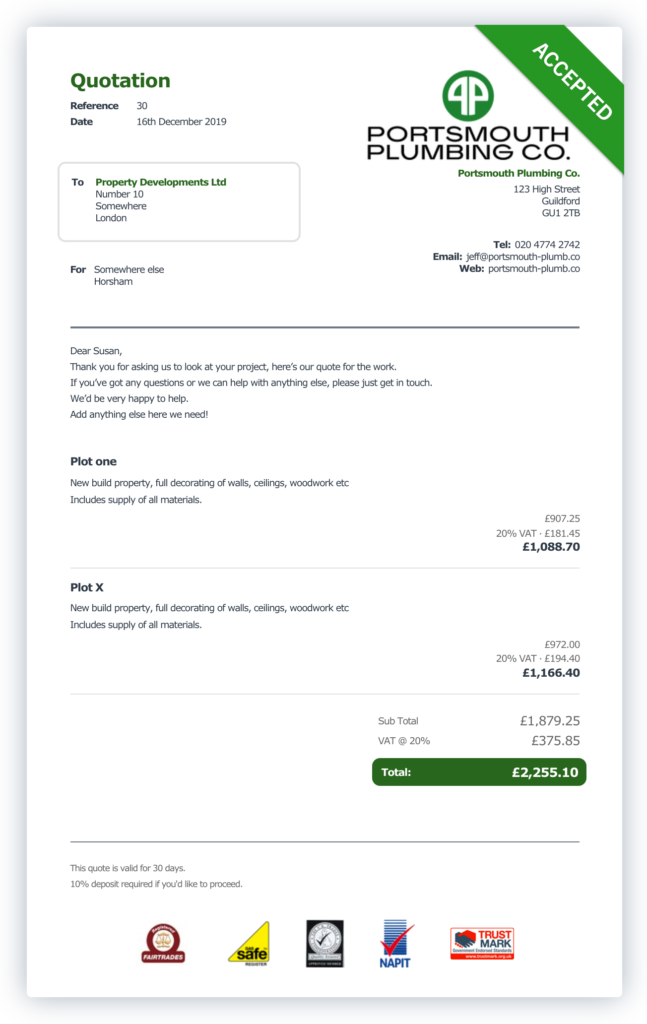
The estimates, quotes and emails you send out are often people’s first clue about how professional your set up really is. So don’t settle. Look for a system that helps you build paperwork you’re really happy with, not just something that’ll have to do – paperwork that’s complete with your logo, trade association logos and business colours.
Trying to crowbar a logo into Word can feel clumsy, unprofessional and a bit of a struggle. It doesn’t have to be that hard. With the right tools, dropping that logo just where you want it is a two-second job, helping you build quotes that give people confidence – and win more work.
Fast ways to find what you need
Trawling through files looking for old notes, quotes and job specs is a frustrating waste of time, and these days you just don’t need to do it. Tools like YourTradebase give you a joined-up way to save, store and find your paperwork, without faffing through folders or being tied to you computer.
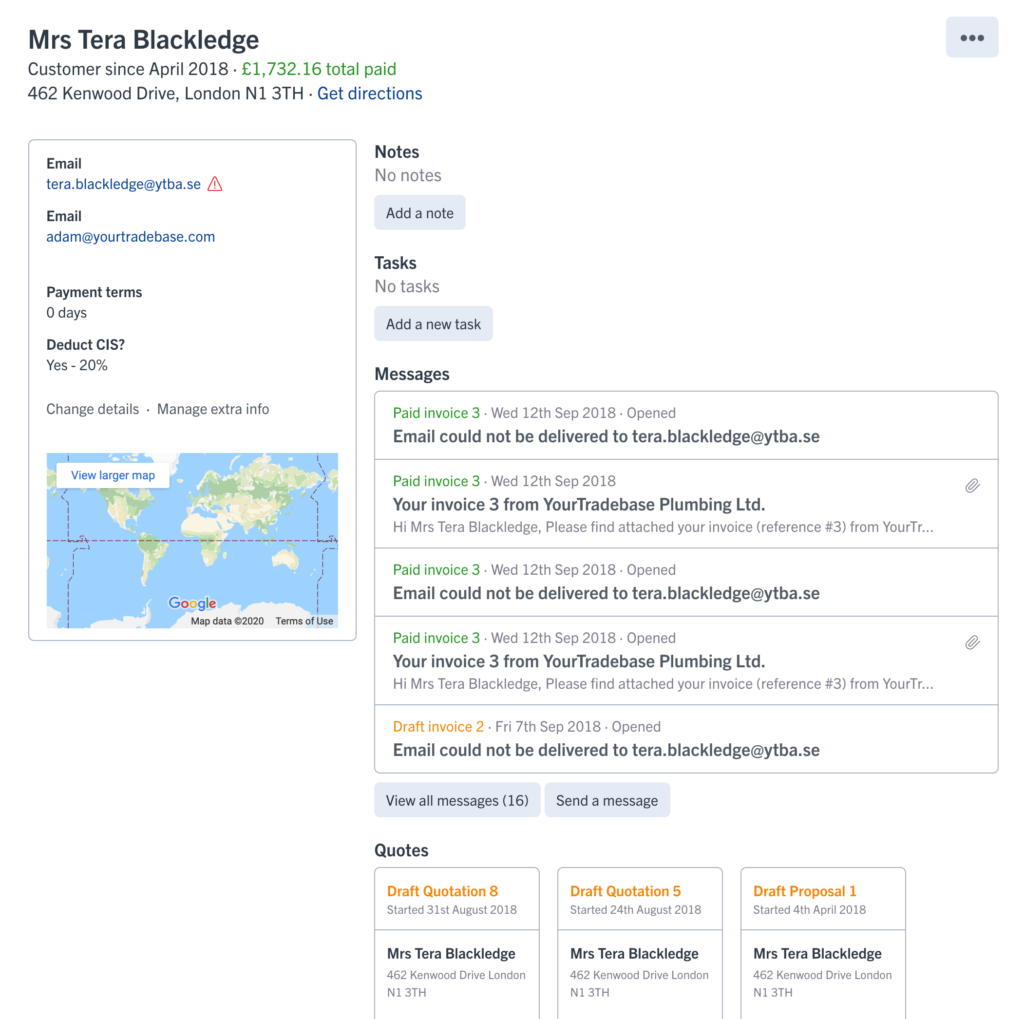
Just look up a customer and see everything you’ve ever done for them, in one place, super fast. You can even search your records on site, on your phone, with the customer standing in front of you. You’ll look super organised and they’ll feel you remember, and value, each of their projects.
Tracking, reminders and other useful stuff
However long you’ve been using them, Word and Excel aren’t going to remind you when it’s time to chase up that invoice, or tell you when your customer’s opened their latest quote. They’re just not built that way. But a tool built for the trades can.
So, take things to the next level by going for a system that lets you track your paperwork, email it instantly, see when it’s been read. A tool that tells you when customers need chasing up, rather than letting things drift. It’s about taking the pressure off you to remember everything – giving you a nudge when you need one, so you can make the most of every lead, and get paid faster.
Go your own way
The thing to remember is, Word and Excel aren’t the only way. You’ve got options – and they’re solid ones that could be real game changers for your business. Finding a system that feels right for you is really important. So try things out and see what works for you.
YourTradebase was designed by trades, for trades, and it does all of the above, plus a tonne more – things like quick customer messaging, linking up to Xero accounting software and even letting your customers view and accept quotes online.
We know how trades work, what makes them tick and the pressures you’re under every day – so we’ve built YourTradebase to be fast, intuitive, straightforward and easy to use on the go. Which means knocking out a quick quote over a cuppa is as easy as it always should have been. If you fancy taking us for a no-strings spin, we even do a free 14-day trial. Ready when you are.
Adam
This year, let’s nail it.
8 January 2020
The presents are open. The pudding’s all gone. The relatives have left the building. So what’s 2020 got in store for you?
Show this year who’s boss. We’ll be with you all the way.
Well, look at that – it’s 2020. I don’t know about you, but 2020 always sounded like the future to me. So here we are, standing in the future. Or, let’s face it, probably sitting.
We made it. Through the pre-Christmas chaos. Through the actual Christmas chaos. Through the New Year’s Eve chaos. And now here we are, at the start of a brand new year. Here’s wishing you and yours a very a happy one.
And if you’re thinking, this is the year I get organised, the year I stop getting bogged down in paperwork, the year I start actually nailing it – we’ve got you.
Because this year we’re going to be bringing you a bunch more ways to smash through your admin, win more work and get your business even more ship shape than before. New tools, new updates and loads more advice, ideas and strategies right here on the blog – starting with a brand new post next week on why you can do better than Word and Excel.
Even better, you can get all our admin-busting blogs straight to your inbox, just by signing up here. No strings, no hassle, just straight-up, sound advice to help you do your thing, better than ever.
Every blog’s based on our five no-nonsense ideas for trading better – follow every lead, have a solid system, be fast and friendly, do admin little and often, and be the pro it’s good to know. They’re not rocket science, but they might just be the jet pack you’re looking for.
Ready? Let’s do this.
Adam
It’s Christmaaaas! (almost)
24 December 2019
It’s finally here. The finish line’s in sight. And there’s a great big pile of mince pies on the other side of it…
Kick off your workbooks and have a cracking Christmas. You’ve earned it (and some).
As someone with a pretty amazing mullet once said, it’s the final countdown. And you might not be headed for Venus, but you’re probably headed for the sofa, your slippers and more mince pies than is strictly advisable. It wouldn’t quite be Christmas otherwise.
So, before you slip off into the sunset, we just wanted to say thanks for coming along for the ride this year. It’s been a good one – our community of hard-grafting, no-nonsense tradespeople has grown and grown, and we couldn’t be happier.
We’ve also introduced a whole bunch of new stuff to help you smash through paperwork, improve your workflow, win more jobs and do your thing, better than ever. Thanks to all of you who’ve given us feedback, left reviews and got in touch to tell us how it’s going. You’re the best.
And next year? We reckon it’s going to be even better. In fact, we’ve been working hard to make sure it is. We’ve got a bunch of new feature launches up our sleeve, including online payments, custom job types and completely new ways to nail that paperwork. We can’t wait to get them live in the app, in your hands and out on site.
So, with this year’s instalment of novelty socks just around the corner, we just wanted to say, enjoy a few well-earned days off. And if you’re craving a bit of festive invoicing, we’ll be here on the help desk right through Christmas and New Year.
We might have crumbs down our Christmas jumpers and Quality Street wrappers in our pockets, but we’ll be here, so if you need us just shout. And if not – see you on the other side.
🎄Have a good one!
When it’s cold outside keep those leads warm
17 December 2019
This time of year is crazy busy. It’s cold, its dark and you’ve got more on your plate than Santa, so prioritising anything that’s not being screamed for is a bit of pre-Christmas miracle. But if you’re after a strong start to 2020, it pays to keep one eye on your leads, get those new quotes in and line up a load of great work for January and beyond…
Right now, it’s tough to look past the festive panic and into another New Year. But with a few nifty tips you can keep quoting, keep winning and keep everyone happy.
Ah, the magic of Christmas. Everyone’s hollering for their projects to be squeezed in, sorted out and finished up before those sleigh bells start ringing. And just to make it even more exciting, the days are short, dark and full of the joys of rain. Brilliant.
So when someone asks you to quote, measure up or answer a few questions, it’s easy to let things slip and not get back to them. We get it. After all, you’re busting a gut to get through your current projects, so loading up with more feels like the last thing you need.
Except it isn’t. It’s exactly, completely, 100% what you need. Because if you want a busy, successful, happy new year, you’ve got to look after those leads. Every call you get, every email, every text, is a lead you’ve earned. It’s yours to run with and that’s a valuable thing. If you’ve ever had a quiet patch, you’ll know leads that land in your lap are absolute gold – so don’t waste them.
After all, when you let leads go cold by waiting too long to call or quote, customers tend to start looking elsewhere. Not just for this job, but for the next one, and the one after that. And before you know it, 2020’s getting off to a pretty quiet start.
Give the people what they want
It’s pretty simple. People want to feel looked after, to believe they matter and, ultimately, to know they’re going to get their project done. Just like you would. So however busy you are, it always pays to be friendly, respond quickly and treat them how you’d want to be treated.
Even if you can’t help this time (there are only so many sleeps till Christmas!), being fast and friendly means they might think of you next time, or decide you’re so good they can wait. Makes sense, right? So how exactly do you find the time when you’re armpit-deep in Christmas chaos?
Well, first up, remember it only takes a few minutes to keep someone happy with a quote, call or quick message. And second, get into the habit. Protecting your workflow for the months ahead means making time every week – even every day – to keep those new leads warm. The good news is, we’ve got a whole load of shortcuts to make it quick and easy…
Take stock (cuppa optional)
If you’re already feeling the pressure, its time to take stock. Half-remembered mental To Do lists just aren’t going to cut it in the pre-Christmas chaos, so grab a cuppa, sit down, and make a list of all the people you need to get back to, and exactly what they need.
Maybe it’s just a call, maybe it’s a pop-in-and-price-up, maybe it’s taking those notes you made and knocking out a smart-looking quote. Whatever it is, get it all out of your head and into a list. You can do it in YourTradebase, on paper – whatever works for you. But do it. And do it soon. You’ll sleep better, you’ll work better and you’ll feel better too.
Next up, work all those things into priority order. Who’s been waiting the longest? Which project’s got the most potential? Who’s a regular you’d hate to lose? Shuffle those jobs till you’re happy, then you’ll be ready to start cracking through them. You could even use our new-look schedule to plan a few in each day. And don’t forget, none of these things actually needs to take long – you’ll be surprised how fast you can blast through them.
Take five (in the van)
Once you get stuck in on site, the day has a habit of running away. There’s loads to do, things crop up, things need fetching and carrying… It’s lunchtime before you know it, and it’s dark about ten minutes later. So carve out five or ten minutes before the chaos begins.
Do it before you hit the road, or as soon as you arrive on site. You can get the team working, then grab some valuable van time to get out that list and get started. That’s the main thing – just start. Make that call, answer that question, send that email. You’d be surprised how much you can do in the time it takes to neck a brew. And every little thing you tick off your list lightens the load, as well as looking after your New Year cashflow.
Take a shortcut
If you dread quoting, make it easier by using a template, or putting together a price list of all your regular tasks and materials so you can pick and choose super fast. You can knock them up in Word or we’ve got both in YourTradebase – and they really do shave loads of time off the job.
It’s easy to get your templates looking super smart too. Add your logo, and the logos of any accreditations you’ve worked for or associations you’ve joined. They’ll make you look like a pro, and once they’re in your template, they’ll be ready to roll every time you quote. Done and dusted.
Templates don’t just come in handy for quoting. You can use them for emails too. If there’s a message you find yourself sending all the time, whether it’s to go with a quote, chase one up or confirm an appointment, get a template you’re happy with, drop a few details in and boom, you’ve made getting back to people a whole lot faster too. We’ve got a whole blog on how, right here.
Take your pick
Finding ten minutes to look after your leads every day really is doable, even when you’re rushed off your feet. But more than that, it’s the best way to avoid quiet patches, be able to pick jobs you really want to do, and keep the money coming in.
So, don’t get swallowed up in the rush. Get organised, get back to people and get in everyone’s good books. It’s a habit that’ll make you feel a whole lot better – and set you up for a really great 2020.
Making a list & checking it twice
27 November 2019
There’s no getting away from it. Christmas is coming – and fast. It’s dark, it’s cold and your customers are getting more impatient than your kids. But push on through and there’s a few days of novelty-jumper-wearing, face-stuffing, cracker-pulling family time on the other side. And we’ve got a few no-nonsense ideas to help you get there in one piece…
Battling through the pre-Christmas chaos means being realistic, getting organised, looking ahead and rounding up all the little helpers you can get. Ready? Let’s do this.
If there’s one thing you can bet your Christmas pudding on, it’s that from now until C-day, it’s going to be busy. If you’re working on a big project, you can bet your customer wants it wrapped up ready for the relatives to arrive. And if your phone’s ringing round the clock, it’s because all those little jobs people have been putting off suddenly feel super urgent with Christmas in sight.
So there’s a rush on. Which is great, if you can keep up. But the days are short, the ground is hard, the light’s awful and you’re freezing your boots off. Not exactly ideal conditions for the busiest time of the year. So what can you do to survive the chaos, keep your customers happy and get to Christmas dinner without going crackers?
1. Write that list
Ok, we’re not talking about that list. It’s good to know you need a novelty phone case and that Strictly DVD, but there’s a different kind of list that might just bring you even more happiness.
When it’s dark too early and the rain’s lashing down, grab a cuppa and take the opportunity to get organised. List out everything that’s on your plate and be realistic about the time and resources you’ve got to get it done. Get an overview of the time left before Christmas, and put everything into a schedule so you can see the space you’ve got (and the space you haven’t).
If you fancy taking it for a spin, we’ve added a whole load more bells and whistles to the scheduling tool in YourTradebase. But whatever tool you use, plan out what you can get done, day by day. It’s the only way to see what you’re up against.
2. Make like Santa
We’ve talked a lot over the last few months about recognising which customers are worth fighting for, and which you’d be better off without. Well, it’s almost Christmas, so make like Santa, put those customer-grading skills to the test and draw up your very own naughty or nice list.
Now more than ever, you need to show your best customers you can get the job done – and push those nightmare customers way down your priority list. So be picky, look after the people who look after you and go spread some festive joy. You can tap into templates like our weekly email update to keep your best customers up to speed with what’s happening, when.
3. Deck the site
It’s not a great time of the year to be working outside, and the shorter days make it harder to meet those deadlines. So get some help – and light up your site. Those multi-coloured fairy lights from the attic probably won’t cut it, so hire some heavy-duty lighting, short term, and squeeze a load more hours into the next few weeks.
4. Call in some little helpers
If it’s good enough for Santa, it’s good enough for you, so round up some little helpers and put them to work (pointy ears and stripy tights optional).
Extra hands on deck will help you get all those jobs finished faster, so call around and see who’s available – even if it’s just for the straightforward stuff that’s slowing you down. Everyone needs a bit of extra money at this time of year, so there’s bound to be someone willing to help. You can even add the whole team to YourTradebase, helping you keep everyone on track, every day.
5. Get cosy in the van
Remember our van time blog? Even though you’re rushed off your feet now, January could easily be deathly, so don’t ignore that paperwork pile. Grab five minutes in the van and smash through those quotes, invoices and admin jobs that’ll make sure you’ve still got a decent workload (and a healthy cashflow) the other side of Christmas.
YourTradebase has great templates and price lists that help you tackle your To Do list super fast. But tap into whatever tools make your life easier – and take five to ease that mental load.
6. Spread some joy
Even if you’re feeling stressed and you’ve got to turn down work, keep things friendly and get back to people quickly. A fast, polite ‘no’ might mean a customer you can’t help now comes back later, recommends you to a friend, or finds they can wait till January after all.
It’s also a great time of year to show your favourite customers how much you value their business with a bit of a Christmas present. A bottle of wine here and a box of chocolates there won’t break the bank, but it’ll be a surprise they remember – and it’ll make a great impression.
Even simpler, send a quick Christmas message in YourTradebase. We’ve set up a template so you can send it to a whole bunch of people, in seconds. After all, it’s the little things that make a difference – and fill your New Year diary with lots of great new projects.
So, start making that list, mapping out that schedule, calling in that help and knocking out those New Year quotes. Look after your best customers, lean on YourTradebase and have yourself a very merry Christmas. After all that graft, you’ve earned it. 🎄
The super quick way to show you’re a pro
18 November 2019
When it comes to winning work, you’ve got to win trust. New customers need to feel comfortable giving you their long-planned projects and hard-earned cash, not to mention their front door keys. So today, we’re looking at one simple way to win that trust… with a few well-placed logos.
If you’ve sweated over trade accreditations or paid to be part of industry associations, don’t keep it to yourself. Flash those logos on your paperwork and make a great impression, fast.
Put yourself in your customers’ shoes. They need a job doing, they can’t do it themselves, they’re looking for an expert – and they invite you to quote. You pop in, you take a look and you fire off a price. But how do they know you’re reliable, responsible and won’t rip them off, when they’ve only met you for five minutes? How about helping them out…
The power of trade accreditations
If you’ve worked for an industry accreditation like TrustMark, Gas Safe, NICEIC or the dozens of others out there, make sure people know about it. You’ve invested time and money to develop your skills and your business. That shows you’re serious about what you do, willing to go the extra mile, and are a professional, conscientious tradesperson. Exactly what every customer wants.
It’s work-winning gold. But only if customers know about it. If they don’t, they’ll struggle to pick you out from the competition – who might not be half as good, or trustworthy. Which is a bit of a waste of all that effort, and a bit of a shame for the customer.
Make your memberships count
The same goes for memberships of trade associations. Being a paid-up member of a respected organisation like NAPIT, the BIKBBI or loads of other trade-focused associations helps people feel you’re an expert, committed to your trade and ready to do high-quality work. These are things they’re actively looking for – but if you don’t tell them, they’ll never know.
Spreading the word
Whatever trade accreditation or membership you’ve got, you’ll be allowed to use the organisation’s logo to get the word out. So, get on their website, download those logos and flash them everywhere you can. After all, if you don’t, someone else will.
You can slap them on your van, wear them on your T-shirts, use them in your adverts and splash them on your signage. But for a super-quick win, how about adding them to your estimates, quotes and invoices? It’ll only take a few minutes, but it’ll make all the difference to the way people see you – and the way they weigh up your quotes against the competition.
Paperwork that says you’re a pro
If you’re using Word to write your invoices, you can drop the logos onto each piece of paperwork and adjust them to fit. Alternatively, try making a template you’re really happy with – complete with trade logos – and typing into it every time you write an estimate, quote or invoice.
If you’re using YourTradebase, it’s even easier. You can upload up to five logos from accrediting bodies or trade associations, save them in your account, and use them whenever you want, right across your paperwork. We’ll automatically size them so they look super professional and you can add them to templates so they’re ready to roll whenever you are. Handy stuff.
Here’s what they look like on a quote…
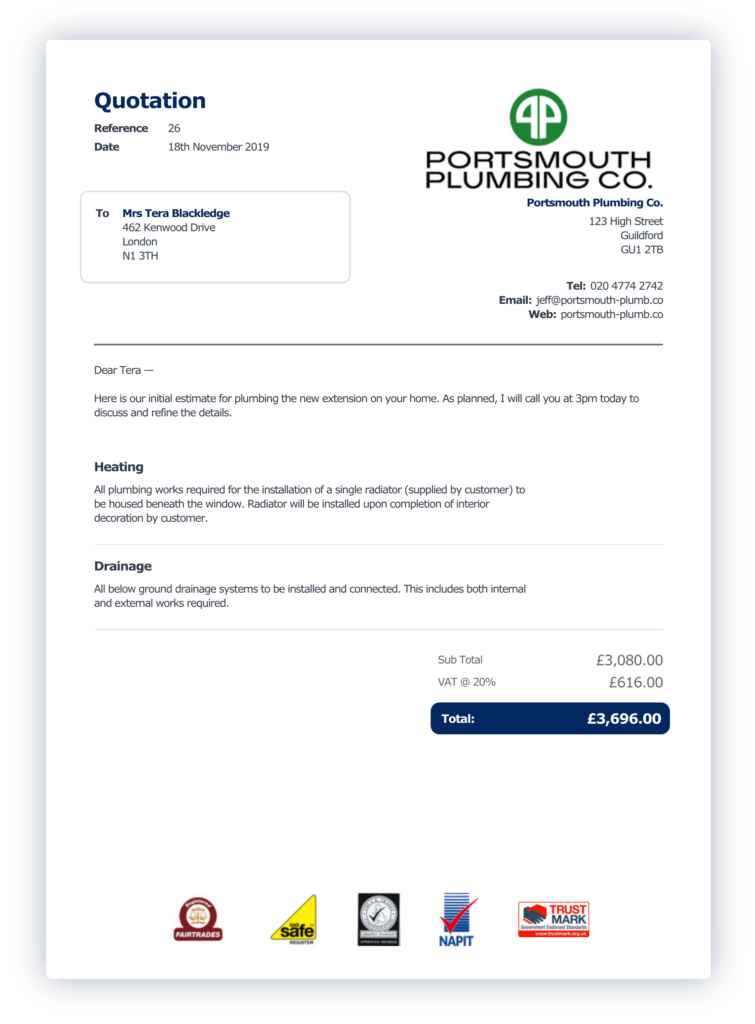
Here’s what they look like on an invoice…
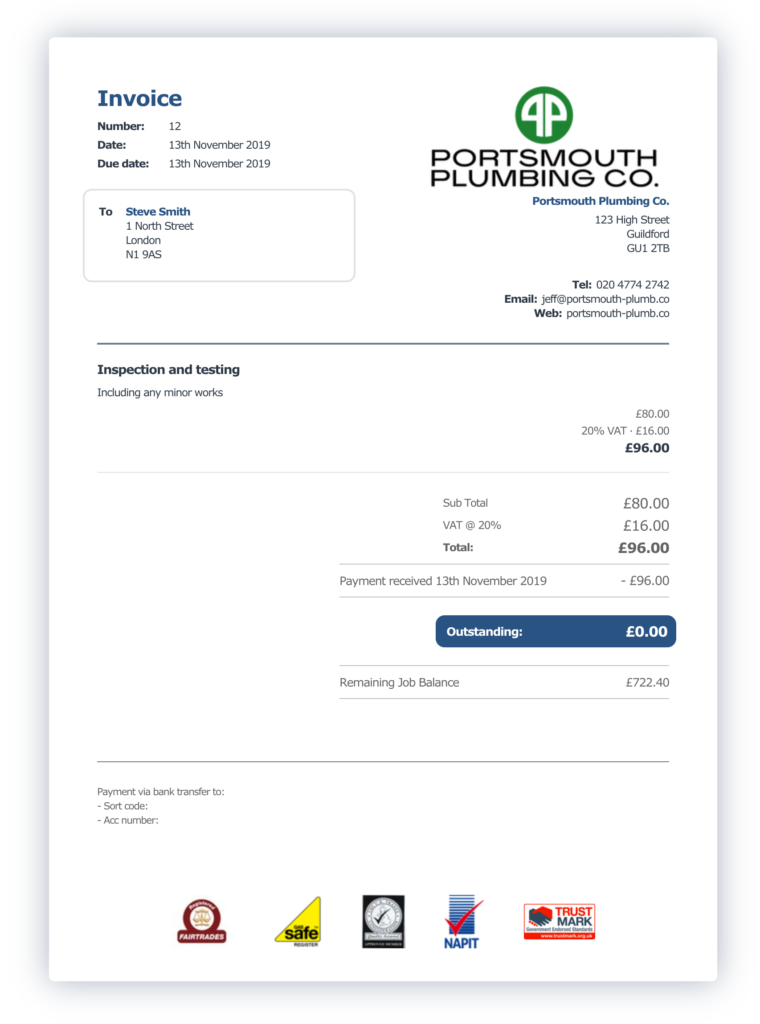
What else can I do to build trust?
Pulling trade logos into your paperwork is a five-minute job you can kick off today. But it’s not the only thing you can do to build customer confidence.
Get into the habit of asking happy customers for feedback and you can quickly build up a bank of great comments about your work. Send a few over with your quote and you’re instantly looking like a strong choice. Even better, add photos of similar projects you’ve worked on. You’ll look professional and organised and you’ll be giving people real reasons to believe in you.
Finally – don’t forget that clear, friendly, professional communication goes a really long way when you’re building trust. Even better, it’s free. So, be up front about what you can do (and when) and stick to it. Keep people in the loop so they know what to expect. And make sure every piece of paperwork looks the business. If you need us, we’re always here to help.
Thinking about getting accredited?
If you haven’t got any accreditations or memberships, they’re definitely worth thinking about. Yes, there’s usually a cost, but it’s an investment that’ll pay for itself pretty fast. Try googling trusted trade bodies in your line of work to see what’s out there and what’s involved.
Why it pays to quote in order
7 November 2019
When it comes to winning work, sometimes it’s the little things that make the biggest difference. Like being clear, logical and transparent with your customers. It builds confidence, trust and long-lasting relationships – and it all starts with that first, easy-to-understand quote…
Your customers aren’t tradespeople. They don’t know the job like you do. So try breaking your quotes down, step-by-step, so they walk them through what you’ll do – in the order you’ll do it.
Whether you’re quoting for a half-day job or a six-month project, the clearer your quote is, the more likely you are to bag the work. Simple really. Potential customers want to know what they’re getting, why they’re getting it and how much it’s going to cost. And why wouldn’t they?
If they’ve asked for a bunch of quotes and the costs are pretty close, but yours is super easy to understand, they’re going to feel more confident choosing you. Which means a well-organised quote can be great for your workflow, your cashflow and your reputation. Even better, it means you’ll get to work with happy, relaxed customers, who like working with you. Worth a go, right?
One simple thing you can do straight away. Today.
Quotes are meant to be helpful to customers, giving them the information they need to make decisions. But if you ask a few, you’ll soon find they’re pretty baffled by the quotes they get, the jargon that’s used and the costs they include. So let’s help them out.
Your quote’s a list of all the things that go into getting the job done. Listing those things in the order you’ll do them shows potential customers a clear journey through the job. (And it’s a pretty handy way to make sure you haven’t forgotten anything too.)
If your quote walks them through the work, they’ll have a better understanding of what’s needed, they’ll know what to expect and they’ll appreciate the costs you include. They’ll also be able to see that you’re organised and know your stuff. Sounds like a no brainer. So could you do it?
How to get started
First things first, list and cost any prep work you’ll have to do, whether that’s removing existing structures, clearing the site or just stripping off the old wallpaper.
Include the labour and materials you’ll need to do it and give this part of the work a simple heading. Something like ‘Site clearance’ or ‘Wallpaper stripping’. List all the tasks involved underneath that heading – you could even use bullet points to make it really readable.
Then move onto the next phase of the work. Maybe you’re digging foundations, levelling a floor or skimming walls. Again, give this part of the work a heading and a cost, listing the separate tasks, labour and materials underneath.
Keep going. Through the brickwork, the fit-out, the plastering, the plumbing. Whatever it takes to get that job done, get it down in your quote so your customer knows how hard you’ll be working. Repeat the whole thing for every phase of the project, right up to snagging. And you’re done.
We’ve all got our own ways of quoting, so shaking things up might feel strange to start with. But go with it. Get that first super-clear, well-ordered quote done and you’ll have an example to follow the next time, and the next, and the next. Until it becomes a habit you’re really comfortable with.
One more thing…
When you’re writing that quote, keep the trade jargon out of it. If your customers were tradespeople they’d be doing the job themselves. They’re not. So write for your audience. Be clear. And make sure anyone could understand that quote. Even your granny.
Want to see the difference quoting in order makes? Here goes.
This one’s quoted in order…
quotation_19_mrs-tera-blackledge_07112019This one’s definitely not…
quotation_20_mrs-tera-blackledge_07112019With the handy templates we’ve built into YourTradebase, it’s easy to write quotes fast, move items around and send out super-clear, logical costs. But whatever tools you use, give quoting in order a go – it’s a really simple way to help customers, win work and boost your business.
Happy quoting!